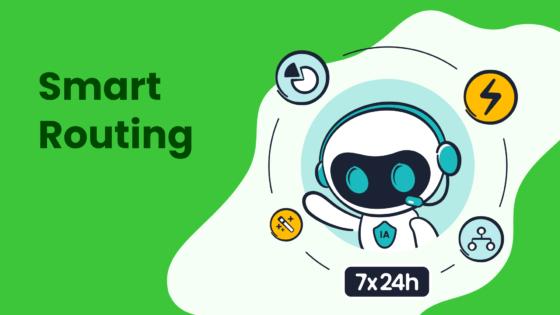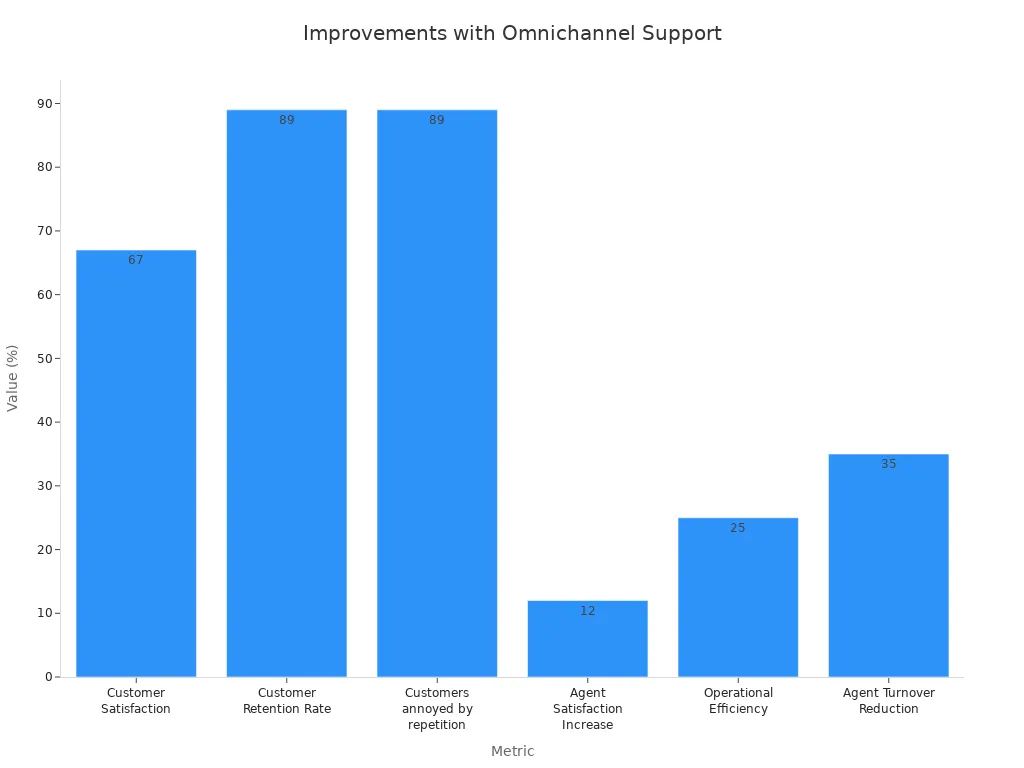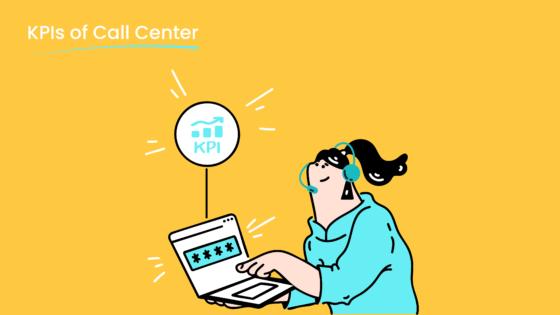Omnichannel vs Multichannel Support A 2025 Comparison Guide

You need the best support for your customers in 2025, and understanding the difference between omnichannel vs multichannel support is crucial. Omnichannel support clearly outperforms multichannel support by providing a unified experience for your customers, whereas multichannel support keeps channels separate and disconnected. This distinction matters because customers today expect seamless, integrated journeys. A strong omnichannel strategy leverages real-time data to deliver personalized support, while multichannel support offers variety but lacks true integration.
Sobot leads the way in omnichannel support with its advanced Sobot AI and a unified workspace that empowers agents to deliver consistent, personalized service. The Sobot call center platform exemplifies how omnichannel support can increase customer retention and drive business growth by connecting all communication channels into one seamless system.
| Aspect | Multichannel Support | Omnichannel Support |
|---|---|---|
| Channel Usage | Multiple channels used independently | All channels integrated into a unified system |
| Customer Experience | Fragmented, channel-specific experiences | Seamless, consistent experience across all touchpoints |
| Messaging | Different messaging tailored to each channel | Harmonized, uniform messaging across channels |
| Personalization | Channel-level personalization | Customer-level personalization using integrated data |
| Strategy Focus | Business-centric, focused on expanding reach | Customer-centric, focused on continuous engagement |
| Data Integration | Limited or no integration between channels | Real-time data integration across channels |
| Example Use Cases | Separate campaigns on email, social media, app | Unified customer journey, e.g., cart abandonment follow-up via multiple channels |
| Objective | Reach varied customer segments via relevant channels | Provide a smooth, connected customer journey |
With Sobot’s omnichannel solution powered by Sobot AI and the robust Sobot call center, businesses can meet and exceed customer expectations by delivering a truly integrated and intelligent support experience.

Omnichannel vs Multichannel Support: Key Differences

What Is Omnichannel Support?
Omnichannel support brings all your communication channels together into one unified platform. You can connect with your customers through phone calls, social media, email, live chat, AI-driven self-service portals, and text messaging. These channels work as a single system, so your agents see every interaction in one place. This means you never have to ask your customers to repeat themselves. You can switch from a chat to a phone call or from an email to a social media message without losing any information.
Omnichannel support uses advanced tools like CRM and AI to personalize every conversation. Your agents know the customer’s history, preferences, and previous issues. This makes the customer experience smooth and consistent. For example, if a customer starts a conversation on Facebook and later calls your support center, your agent already knows what the customer needs. This seamless transition saves time and builds trust.
Here are the most common channels you can integrate with omnichannel support in 2025:
- Phone calls
- Social media platforms (TikTok, Facebook, Instagram, Pinterest)
- Live chat on company websites
- AI-driven self-service portals
- Text messaging
Omnichannel support is not just about being present everywhere. It is about creating a connected journey for your customers. You can use data and automation to solve problems faster and offer a personalized experience every time.
Tip: Omnichannel support helps you deliver a unified brand message and ensures your customers always feel valued, no matter how they reach out.
What Is Multichannel Support?
Multichannel support means you offer help to your customers on many different platforms. You might use email, social media, print, mobile, display ads, television, and radio. Each channel works on its own. Your team manages each channel separately, and customer data stays in silos. If a customer contacts you on Instagram and then sends an email, your agents may not know about the earlier conversation.
Multichannel support focuses on being available wherever your customers are. You can reach different groups through different channels. For example, you might use TikTok for brand awareness, Instagram for community engagement, and LinkedIn for professional networking. Each channel has its own strategy and goals.
Here are typical channels included in multichannel support strategies:
- Social media platforms (TikTok, Instagram, LinkedIn, YouTube, Twitter, Pinterest, Facebook)
- Email and mobile marketing
- Print, display ads, television, and radio
In multichannel retail, you might run separate campaigns for each channel. Your customers can choose how they want to connect, but their experience may feel disconnected. Agents may not have access to the full customer history, which can lead to repeated questions and slower resolutions.
Note: Multichannel support gives you a wide reach, but it can create a fragmented customer experience if your channels do not work together.
Why Key Differences Matter in 2025
The key differences between omnichannel and multichannel support have become more important than ever in 2025. Customers expect fast, seamless, and personalized service across all touchpoints. They want to move from one channel to another without repeating themselves. Omnichannel support meets these expectations by integrating all channels and customer data into one system. This approach creates a unified customer journey and a consistent experience.
Let’s look at the core functional differences in a table:
| Feature/Aspect | Omnichannel Support System | Multichannel Support System |
|---|---|---|
| Integration | Channels (phone, chat, email, social media) are integrated into a unified platform | Channels operate independently without integration |
| Customer Data Access | Centralized customer data accessible to agents | Data is siloed per channel |
| Customer Experience | Seamless, consistent across all channels; agents know customer history | Inconsistent experience; agents may not have full interaction history |
| Risk of Customer Transfer | Reduced risk of customers being transferred repeatedly | Higher risk of customers being passed around without continuity |
| Personalization | Uses CRM and AI-driven routing for personalized, frictionless service | Focuses on presence across channels without unified experience |
| System Focus | Unified platform for support operations | Multiple separate systems for each channel |
In omnichannel retail, you can track your customer’s journey from online browsing to in-store pickup. You can send personalized offers based on their behavior and preferences. This level of integration leads to higher satisfaction, loyalty, and revenue. Google reports that omnichannel strategies can boost store visits by 80%. Customers who use multiple channels tend to spend more and shop more often.
In contrast, multichannel retail often struggles to meet these rising expectations. The lack of integration can cause delays, repeated questions, and inconsistent messaging. As a result, customers may feel frustrated and less loyal.
Here are some trends driving the need for omnichannel vs multichannel support in 2025:
- Customers expect seamless, consistent brand experiences across all channels—online, mobile, wearable, and physical stores.
- Personalized journeys powered by AI and data analytics are now standard.
- Customers want to shop and get support anytime, anywhere.
- Social media usage is at an all-time high, making integrated support essential.
- Businesses that unify customer data can offer proactive, predictive engagement.
Remember: The key differences between omnichannel and multichannel support can make or break your customer experience in 2025. Omnichannel support helps you stay ahead by meeting customer needs for speed, personalization, and convenience.
Omnichannel Customer Support: Benefits
Unified Experience
You want your customers to enjoy a unified experience across channels. Omnichannel customer support connects every touchpoint, so your customers never feel lost or forced to repeat themselves. When you use omnichannel, your team sees all customer interactions in one place. This unified experience means your customers get consistent answers and faster solutions. In omnichannel retail, you can track a customer’s journey from browsing online to picking up in-store, creating a seamless shopping experience. Studies show that integrated customer service boosts satisfaction and loyalty. Customers feel valued when you handle complaints, returns, and questions the same way on every channel.
| Metric | Omnichannel Support Value | Comparison / Impact |
|---|---|---|
| Customer Satisfaction (CSAT) | 67% | 139% improvement over multichannel (28%) |
| Customer Retention Rate | 89% | Compared to 33% without omnichannel |
| Customers annoyed by repetition | 89% | Eliminated by omnichannel communication continuity |
| Agent Satisfaction Increase | 12% | Due to improved tools and interaction quality |
| Operational Efficiency | +25% | Improvement with AI-enabled omnichannel platforms |
| Agent Turnover Reduction | 35% | Lower turnover compared to traditional multichannel |

Personalization & AI Integration
Omnichannel customer support uses AI to personalize every interaction. You can analyze customer behavior and preferences, then create targeted marketing campaigns and personalized service. AI-powered tools help you predict what your customers need before they ask. You can send recommendations, special offers, and updates that match each customer’s interests. AI gathers data from every channel, building a complete profile for each customer. This leads to a smoother customer experience and improved customer satisfaction. In omnichannel marketing, you can use predictive analytics to engage customers proactively. Real-time inventory management ensures products are available when and where your customers want them.
- AI creates personalized homepages and marketing messages.
- Predictive analytics help you anticipate customer needs.
- Unified data enables consistent communication and targeted offers.
- Virtual try-on apps let customers see products tailored to their style.
Sobot Omnichannel Solution
Sobot’s omnichannel customer support platform gives you powerful tools for a unified experience. You get AI-driven automation, a unified workspace, and easy integration with platforms like Salesforce and Shopify. Sobot’s solution lets your agents manage calls, chats, emails, and social media from one dashboard. You can automate repetitive tasks, freeing your team to focus on complex issues. Sobot’s analytics help you monitor performance and optimize your support strategy.
Opay, a leading financial service platform, used Sobot’s omnichannel solution to connect social media, email, and voice channels. Opay saw customer satisfaction jump from 60% to 90%. Operational costs dropped by 20%, and conversion rates increased by 17%. Sobot’s unified experience helped Opay deliver seamless support and effective omnichannel marketing. You can read more about Opay’s success on Sobot’s website.
Tip: Sobot’s omnichannel customer support helps you build loyalty, reduce costs, and deliver a consistent, personalized experience every time.
Multichannel Support: Pros & Cons
Channel Variety
You can reach your customers through many different channels with multichannel support. Multichannel marketing gives you the flexibility to connect with people on social media, email, mobile apps, and even in-store. This approach works well in multichannel retail, where customers expect to see your brand in many places. You can run separate campaigns on Instagram, Facebook, and email, each with its own message. Multichannel customer support lets you meet your audience where they are most comfortable. This variety helps you expand your reach and attract new customers who prefer different ways to interact.
Tip: Multichannel marketing helps you test which channels work best for your business. You can adjust your strategy based on what your customers respond to most.
Simplicity & Resource Needs
Multichannel support is often easier to set up than omnichannel systems. You do not need to connect every channel or build a complex data integration. Multichannel marketing uses less technology and fewer resources, making it a good choice for businesses with limited budgets or those just starting to expand. You can manage each channel separately, which means you do not need advanced data management or ongoing integration work. Multichannel customer support allows you to add or remove channels as your business grows. This flexibility keeps costs lower and makes it easier to maintain your support operations.
- Multichannel support requires less investment in technology and integration.
- You can use basic marketing automation tools without building a unified system.
- Multichannel marketing is less complex and less costly to maintain.
- Businesses with fewer resources often choose multichannel customer support to start.
Limitations in Customer Experience
Multichannel support has some important drawbacks. Customers often face inconsistent experiences because each channel works alone. If a customer contacts you on social media and then emails your team, agents may not see the full conversation. This can lead to repeated questions and slower problem-solving. Multichannel marketing sometimes overwhelms customers with too many messages or confusing FAQ pages. Ineffective chatbots and siloed channels can frustrate users, causing them to return to traditional support like phone calls. In multichannel retail, the weakest channel can hurt your brand’s reputation and lower customer satisfaction.
- Customers may struggle to get help if channels are not connected.
- Poor self-service options and irrelevant chatbot answers can cause frustration.
- Inconsistent experiences across channels can harm your brand image.
- Customers may abandon new channels and return to old ones if they do not get the help they need.
Note: Multichannel customer support gives you reach and flexibility, but it can limit the quality of your customer experience if channels do not work together.
Omnichannel vs Multichannel Support: Comparison

Customer Experience
You want every customer to feel valued. Omnichannel customer support gives you a seamless journey. Customers move between channels without repeating themselves. Agents see the full history, so they solve problems faster. Multichannel support offers choices, but each channel stands alone. Customers may get different answers depending on where they reach out. This can lead to confusion and frustration. Omnichannel improves overall customer experience by connecting every touchpoint. Multichannel can create gaps that lower customer satisfaction.
Tip: A unified approach helps you build trust and loyalty with your customers.
Data Integration
Omnichannel systems bring all customer data together. You get a complete view of each customer’s interactions and preferences. Multichannel support keeps data in silos. Agents may miss important details. Integrating data across channels is hard. You face challenges like:
- Diverse channels and data sources that do not connect easily
- Organizational silos that block data sharing
- Fragmented customer data that makes unified profiles difficult
- Technology limits that require investment in CRM and integration platforms
- Real-time responsiveness needs instant data sharing
Omnichannel customer support uses advanced tools to overcome these challenges. You maintain consistent messaging and improve customer experience. Multichannel support struggles with data quality and collaboration.
Scalability
Omnichannel grows with your business. You add new channels and keep everything connected. Agents handle more requests without losing track of customer history. Multichannel support expands by adding channels, but each one needs separate management. This can slow down your team and make scaling harder. Omnichannel lets you serve more customers while keeping service quality high.
Cost & Resources
You invest more in omnichannel at first. You need integrated systems and training. Over time, you save money by improving efficiency and reducing repeated work. Multichannel support costs less to start. You manage each channel separately, so you spend less on technology. However, you may pay more later due to lower customer satisfaction and higher agent workload. Omnichannel customer support helps you use resources wisely and boost customer satisfaction.
Choosing the Right Support Strategy
Business Size & Needs
You need to match your support strategy to your business size and goals. Small businesses often choose a multichannel marketing strategy because it is easier to set up and manage. You can reach customers on social media, email, and phone without building complex systems. This approach works well if you want flexibility and lower costs. You can add or remove channels as your business grows.
Larger companies benefit from an omnichannel strategy. You can unify all customer interactions and create a seamless experience. This helps you manage high volumes of requests and maintain consistent service. An omnichannel approach supports advanced features like AI-driven automation and real-time data sharing. You can track every customer journey and personalize support at scale.
| Factor | Omnichannel Strategy | Multichannel Strategy |
|---|---|---|
| Integration | Requires robust technological integration to centralize customer data and unify channels. | Channels operate independently, often lacking integration, leading to fragmented customer experiences. |
| Data Security & Privacy | Must ensure compliance with data protection regulations and safeguard customer information across channels. | Also requires data security but may be simpler due to less integration complexity. |
| Customer Expectations | Focuses on delivering seamless, personalized, and consistent experiences across all touchpoints. | Offers multiple touchpoints but may result in inconsistent and disconnected customer journeys. |
| Resource Allocation | Typically demands higher initial investment and ongoing maintenance for integration and coordination. | Generally more budget-friendly with less complex infrastructure requirements. |
| Organizational Alignment | Needs strong cross-department collaboration to maintain unified customer experience. | Less internal alignment needed as channels function more independently. |
You should assess your resources, target audience, and business goals before choosing a support strategy. If you want to build brand loyalty and deliver consistent service, an omnichannel marketing strategy is the best choice. If you need flexibility and broad reach, a multichannel marketing strategy may suit your needs.
Customer Expectations
Your customers expect fast, personalized, and seamless support. In 2025, most customers want you to resolve issues quickly and in a single interaction. They value friendly service and clear communication. You must meet these expectations to improve customer satisfaction and loyalty.
- Customers expect proactive support that solves problems before they arise.
- AI-driven automation and human empathy are both important for efficient service.
- Seamless omnichannel experiences are required, with context maintained across chat, email, phone, and social media.
- Personalization at scale makes customers feel understood and valued.
- Data security and privacy are essential. Customers want transparency and protection of their information.
- Employee training and upskilling help you deliver high-quality support.
You need to respond quickly. Studies show that 82% of customers expect fast issue resolution. Over half want their problems solved in one interaction. Most customers expect a response within 24 hours on social media, and many want answers in less than 10 minutes. You must personalize communication, even when using automation, to make customers feel valued.
Tip: Meeting customer expectations with an omnichannel strategy helps you build loyalty and stand out in a crowded market.
Technology & Integration
You must consider your technology and integration needs when choosing a support strategy. An omnichannel strategy requires advanced systems that connect all channels and centralize customer data. You need tools that support AI-driven automation, real-time analytics, and unified workspaces. Sobot’s omnichannel solution integrates with platforms like Salesforce and Shopify, making it easy to manage customer interactions.
A multichannel marketing strategy uses simpler technology. You can manage each channel separately and use basic automation tools. This approach works if you have limited resources or do not need deep integration. However, you may face challenges with data silos and inconsistent customer experiences.
You should evaluate your current systems and future needs. If you want to scale your business and deliver personalized support, invest in omnichannel technology. If you need a quick setup and lower costs, multichannel customer support may be enough.
Note: Technology drives your support strategy. Choose tools that match your business goals and customer expectations.
Sobot Voice/Call Center

You need a reliable solution to manage voice and call support. Sobot’s Voice/Call Center product gives you a stable, scalable platform for customer support. You can use intelligent IVR to route calls, automate outbound tasks, and track call data. The unified workspace lets your agents see all customer information in one place. You can integrate the system with your CRM and other platforms for seamless service.
Sobot’s Voice/Call Center supports global telephony contacts and offers 99.99% uptime. You can deploy the system quickly and manage calls from anywhere, including mobile devices. AI-powered voicebots help you recognize customer intent and provide fast answers. You can monitor performance and analyze data to improve your support strategy.
If you want to build an omnichannel strategy, Sobot’s Voice/Call Center fits perfectly. You can connect voice, chat, email, and social media into one system. This helps you deliver consistent, personalized support and improve customer satisfaction. If you prefer a multichannel marketing strategy, you can use Sobot’s Voice/Call Center as a standalone solution for phone support.
Tip: Sobot’s Voice/Call Center helps you scale your support operations and deliver high-quality service across all channels.
Criteria for Choosing Your Support Strategy
You should use these criteria to decide between omnichannel and multichannel support:
- Business Goals: Choose an omnichannel strategy if you want seamless experiences and brand loyalty. Select a multichannel strategy for flexibility and broad reach.
- Customer Expectations: Use omnichannel marketing to meet demands for fast, personalized, and consistent support. Multichannel marketing works if your customers value choice and independence.
- Technology Readiness: Invest in omnichannel systems if you need integration and automation. Use multichannel customer support if you want simple, separate channels.
- Resource Allocation: Omnichannel requires higher investment and ongoing maintenance. Multichannel is budget-friendly and easier to manage.
- Scalability: Omnichannel marketing strategy supports growth and unified service. Multichannel marketing strategy allows you to add channels as needed.
| Criteria | Omnichannel Strategy | Multichannel Strategy |
|---|---|---|
| Customer Experience | Seamless, unified | Fragmented, channel-specific |
| Data Integration | Centralized, real-time | Siloed, limited |
| Personalization | High, AI-driven | Channel-level only |
| Cost | Higher initial, lower long-term | Lower initial, higher long-term |
| Scalability | Easy to expand, unified | Channel-by-channel |
You should review your business needs, customer expectations, and technology before making a decision. Sobot’s solutions help you build the right support strategy for your goals.
You should choose omnichannel support if you want a seamless experience for every customer. Omnichannel connects all channels and gives your team a complete view of each interaction. Multichannel support offers variety, but it can create gaps in service. Assess your business needs and customer expectations before deciding. To get started, explore Sobot’s solutions for unified support. Visit Sobot’s website or contact marketing@sobot.io for more information.
FAQ
What is the main difference between omnichannel and multichannel support?
Omnichannel support connects all your channels into one system. Multichannel support keeps each channel separate. With omnichannel, you give customers a seamless experience. Multichannel support offers variety, but customers may repeat themselves or get inconsistent answers.
Why does omnichannel support improve customer satisfaction?
You provide a unified journey with omnichannel support. Agents see every interaction, so customers never repeat information. Studies show omnichannel support can boost customer satisfaction rates by up to 30% compared to multichannel support.
Can small businesses use omnichannel marketing strategies?
Yes, small businesses can use omnichannel marketing. You start with a few channels and connect them as you grow. Omnichannel support helps you build loyalty and deliver consistent service, even with a small team.
How does AI help in omnichannel vs multichannel support?
AI in omnichannel support personalizes every interaction. You use customer data from all channels to predict needs and automate tasks. In multichannel support, AI works only within each channel, so personalization is limited.
Is it expensive to switch from multichannel to omnichannel support?
Switching to omnichannel support may need an initial investment in technology and training. Over time, you save money by improving efficiency and reducing repeated work. Many businesses see a strong return on investment with omnichannel marketing.
See Also
Comprehensive Overview Of Omnichannel Call Center Platforms
Step-By-Step Process For Deploying Omnichannel Contact Centers
Best Contact Center Software Evaluated For The Year 2024
